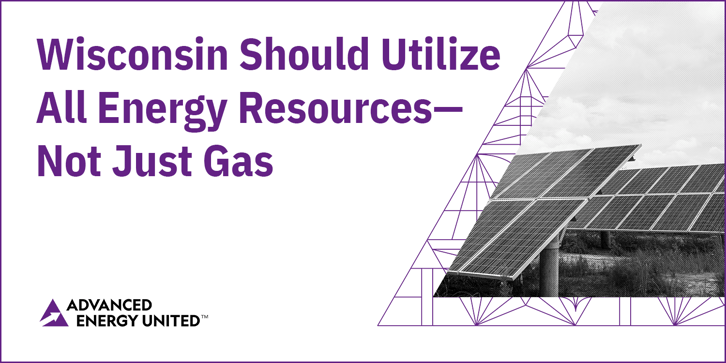
Addendum July 16, 2025: On July 2, 2025 the Public Service Commission of Wisconsin (PSCW) released its written order for the decision on the Oak Creek gas plant. Despite intervenor testimony demonstrating that energy efficiency programs, virtual power plants (VPPs), and distributed generation could provide a cost-effective alternative to part of the requested load, the PSCW approved the project in full. Despite WEC Energy Group artificially capping the amount of wind allowed in its modeling and not considering any kind of VPPs, the Commission considers this project compliant with the Energy Priorities Law. The order directs the opening of an investigation examining cost overruns and how to develop a consistent approach across the state. Additionally, the PSCW directs WEC to include an analysis of a robust and comprehensive demand response program in their next rate case, which will be in 2026.
After a robust exchange of testimony, arguments, and briefings among stakeholders, the fate of We Energies’ (WEC) proposal to spend $1.2 billion on a new gas plant – a plant the utility plans to use just 10-20% of the time – now rests with the Public Service Commission (PSC) of Wisconsin. Formal proceedings before the PSC concluded on April 11, and a decision is expected in the coming weeks.
With the demand for electricity rising for the first time in 20 years and no formal state process for comprehensive, vetted, and long-term planning, Wisconsin is caught in a bit of a dilemma: How can customers, regulators, and energy providers be confident that what we build today will be useful and needed in the coming years? With each proposal for new energy generation resources, like gas plants, stakeholders and state regulators are having to evaluate them in a bit of a silo and with too few tools to evaluate newer, proven advanced technologies.
WEC’s proposal to convert the Oak Creek Coal Plant near Milwaukee into a natural gas peaker plant is a good example of how isolated and outdated planning processes can lead to unnecessarily expensive and risky investments. Advanced Energy United (United) got involved in this case to present evidence that WEC could meet demand with clean energy solutions that are more economical for customers than a large gas plant that will produce electricity at a cost reliant on the volatility of gas prices. Now, the PSC must consider whether to grant the utility’s request to construct and operate this power generation facility.
Instead of WEC’s gas plant proposal, United urged the PSC to consider a wide-ranging suite of solutions that could more cost-effectively meet load growth in the southeastern portion of the state. The utility should use all the tools at its disposal, including virtual power plants (VPPs), energy efficiency programs, more distributed generation in homes and businesses, large-scale renewables, and grid enhancing technologies that make transmission more efficient. A combination of these technologies, which are already being utilized across the country, would cost-effectively and quickly meet this area’s increasing demand. Compared to gas, these technologies are more affordable, reliable, and can be built more quickly.
But WEC seems to have largely overlooked these resources. Throughout the Oak Creek case, United has sought to understand how WEC came to the decision that such expenditures are necessary and reasonable, and why demand response, efficiency programs, and other advanced technologies do not play a greater role in meeting electricity demand. WEC’s answer: it didn’t even consider, even with artificial constraints, these resources in its modeling.
The Oak Creek plant that WEC is proposing is large—1100 Megawatts (MW)—which is enough to power about 800,000 homes, according to the Milwaukee Journal Sentinel. For reference, Milwaukee has about 262,000 homes. To be granted permission to move forward with this project, WEC needs to demonstrate that this proposal is both warranted and the best way to meet demand for the utility, load customer, and ratepayers. With that threshold in mind, customers should be able to confidently know WEC did all it could to evaluate where existing demand can be trimmed during peak hours.
In fact, Wisconsin’s Energy Priorities Law, on the books since 1993, requires WEC to thoroughly evaluate energy efficiency options when planning for new generation. The EPL states that in meeting energy demands, it is the policy of the state to consider options based on the following priorities, in this order:
Energy conservation and efficiency; Noncombustible renewable energy resources; Combustible renewable energy resources; Nonrenewable combustible energy resources, in this order - Natural gas, Oil or coal with a sulphur content of less than 1%, All other carbon–based fuels.
Thus, WEC, in accordance with this long-standing state law, is required to look at efficiency measures and evaluate how it can help meet demand before it even looks at the potential for additional fossil fuels. Wisconsinites want new businesses, residents, and jobs to find a home in the Badger State, but this will become increasingly difficult if proposals to meet their energy needs are slower, more expensive, and outdated compared to those in neighboring states. Approaching the load growth dilemma on a siloed, case-by-case basis runs the risk that Wisconsinites will find themselves in a continued loop of expensive fossil fuel proposals. It’s in the best interest of the families and businesses that pay electric bills for utilities to fully examine and take advantage of advanced technologies to ease the strain on the grid. We need to use all available tools to meet this moment of load growth.
Read more from Emma Heins about the Oak Creek proposal. To learn more about United’s work in Wisconsin, read about our goals and vision.